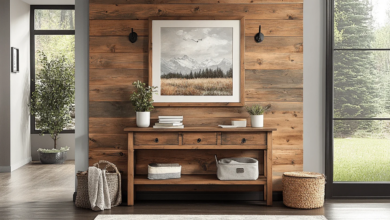63 Stylish and Sustainable Interior Ideas for the Ultimate Eco-Chic Bedroom Makeover
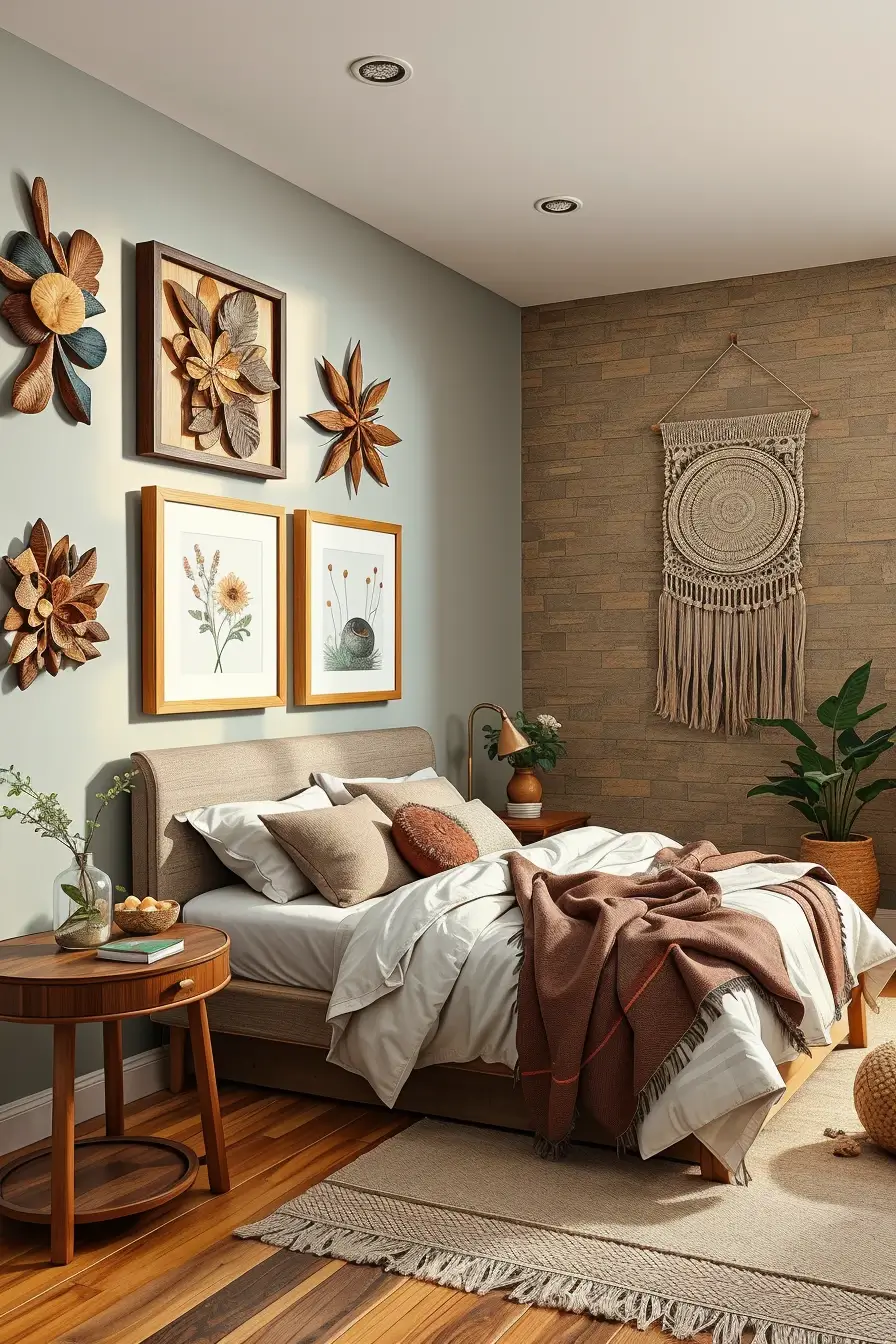
Are you aiming to create a bedroom that’s both stylish and environmentally responsible? Achieving a beautiful, comfortable space doesn’t require compromising sustainability. Thoughtful choices lay the foundation for eco-friendly interiors. This guide will walk you through designing an eco-chic bedroom that harmonizes aesthetics, practicality, and green living. From selecting sustainable materials to smart decluttering, you’ll discover how to embed eco-consciousness into every corner of your sanctuary.
By the end of this article, you’ll be inspired and equipped to craft a bedroom that feels airy and rejuvenating, while actively reducing waste, minimizing your carbon footprint, and fostering a healthier lifestyle. Let’s explore the key components that turn a bedroom into a restful retreat and a model of sustainable design.
Embarking on Your Eco-Chic Bedroom Journey
When envisioning an eco-chic bedroom, I think of a space that marries elegance with environmental mindfulness. Sustainable design is about balancing wellness, comfort, and style in a way that benefits both you and the planet. More people today are embracing eco-friendly bedrooms, recognizing that the advantages extend beyond personal health to global impact.
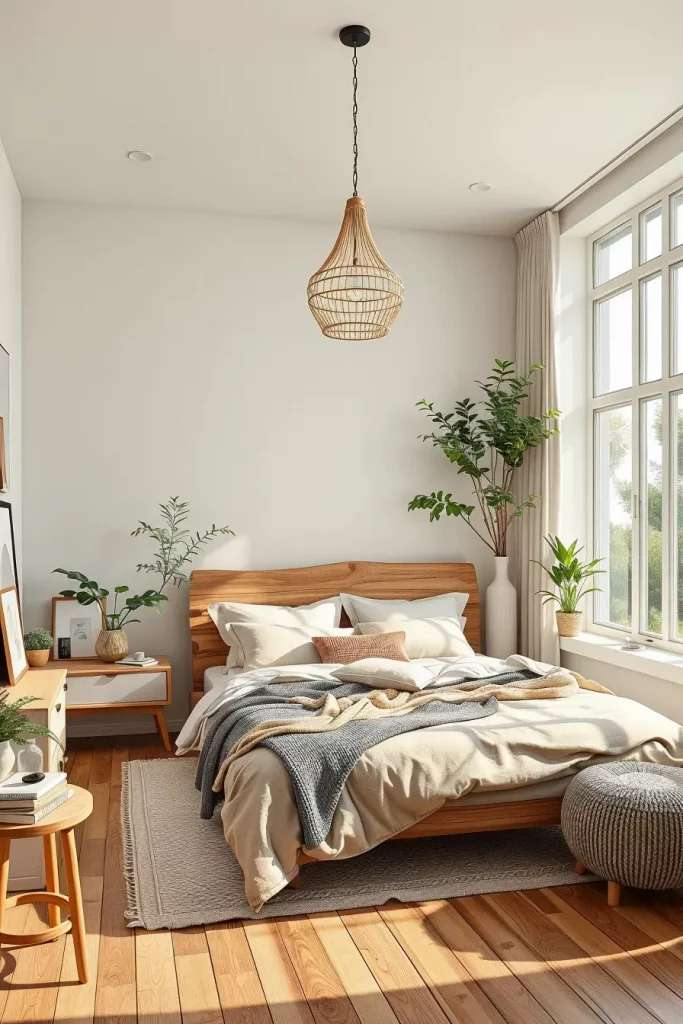
My approach begins with prioritizing eco-conscious materials throughout-from furniture to textiles-since every choice influences environmental and indoor health. For an eco-chic bedroom, I favor natural, neutral textures and fabrics that create a serene escape. This reflects a commitment to responsibility and intentional living.
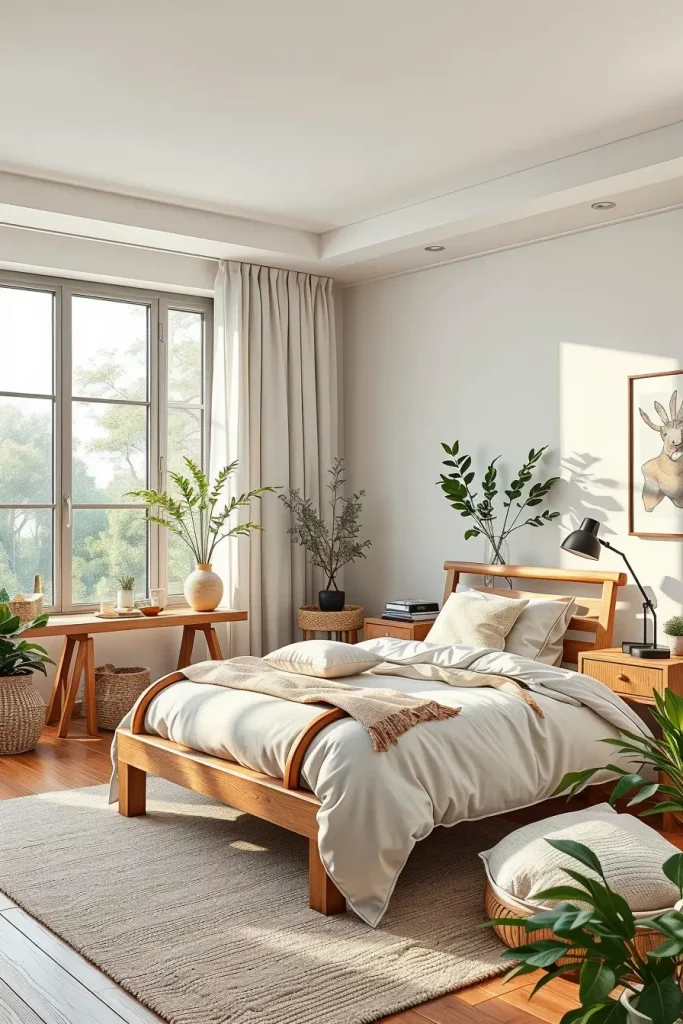
Eco-chic design principles enable you to craft a bedroom that is both stylish and soothing. Contemporary elegance need not be sacrificed for sustainability. As noted by experts in Architectural Digest, eco-friendly homes don’t have to blend invisibly into nature; instead, they can complement it through timeless design, natural materials, and thoughtful details that celebrate your individuality.
Core Tenets of Sustainable Interior Design
To me, sustainability in interiors starts with mindfulness. Every item in the bedroom should serve a purpose, enhance beauty, and avoid unnecessary waste. Eco-chic design considers the entire lifecycle of products-focusing on durability, energy efficiency, and ethical sourcing-so that each piece carries both function and character.

When choosing furniture and décor, I lean towards timeless, well-crafted pieces rather than fleeting trends. This often means fewer items but of superior quality. Natural materials like reclaimed wood, bamboo, and cork paired with minimalist layouts and clean lines create a calming, balanced environment.
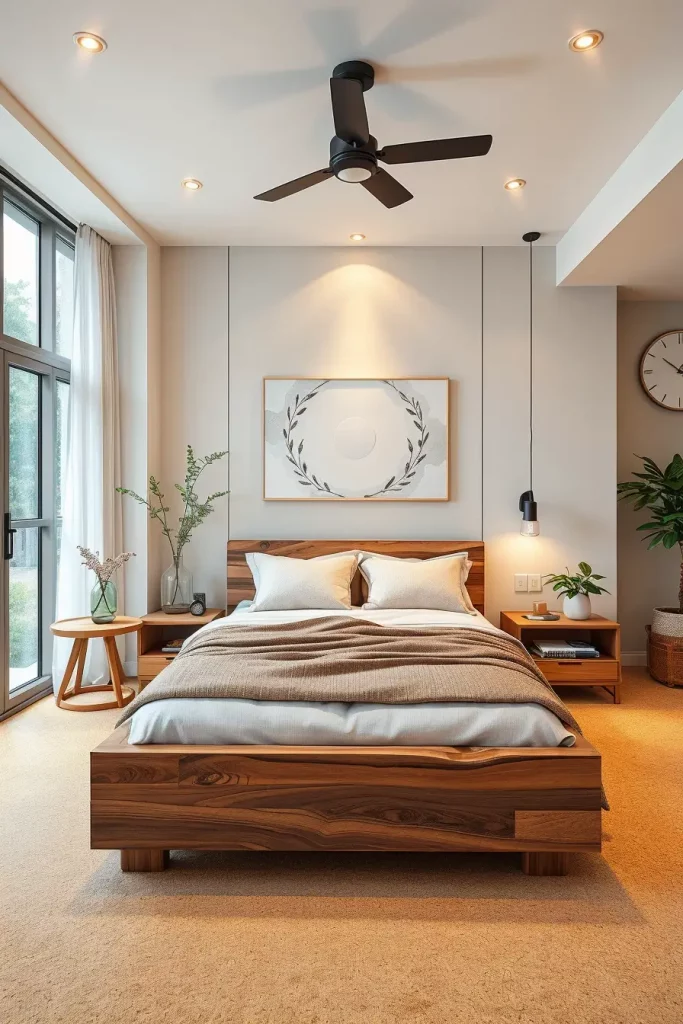
Adopting these principles also curbs impulsive purchases. Investing in enduring designs reduces long-term costs and promotes well-being. Simple sustainable steps, such as using low-VOC paints or energy-efficient lighting, significantly improve indoor air quality and lower energy bills, as highlighted by The New York Times.
Moreover, embracing a circular economy mindset-where items are reused, repurposed, or recycled instead of discarded-elevates the bedroom from a mere resting place to a thoughtful, eco-conscious haven.
Choosing Eco-Friendly Textiles to Define Your Bedroom
Every bedroom has its own character, and textiles play a pivotal role in shaping that identity. I start by selecting eco-conscious fabrics such as organic cotton, hemp, bamboo, and reclaimed wood accents. These materials reduce reliance on synthetics and infuse warmth and comfort into the space.

Each material offers unique benefits: bamboo is a fast-growing, renewable resource ideal for flooring or accent furniture; organic cotton and hemp fabrics are breathable and perfect for bedding or curtains; reclaimed wood adds texture and character while being sustainable.

Supporting local sourcing is another impactful choice. It benefits regional businesses and reduces carbon emissions from transportation. Many designers, myself included, advocate for prioritizing local materials whenever feasible to enhance eco-friendly design.
Additionally, verifying material certifications like GOTS (Global Organic Textile Standard) and FSC (Forest Stewardship Council) ensures authenticity and traceability, reinforcing the eco-friendly integrity of your bedroom.
The Timeless Charm of Reclaimed Wood Furniture
In sustainable interiors, reclaimed wood is a cornerstone material. Its distinctive grains and knots tell a story, lending warmth and authenticity that newly manufactured wood cannot replicate. This makes it ideal for eco-chic bedrooms.

I often craft bed frames, nightstands, and wardrobes from reclaimed wood. Its durability guarantees longevity, while its rustic appeal softens modern lines, creating a harmonious balance. Pairing these pieces with simple, natural textiles enhances the serene atmosphere.
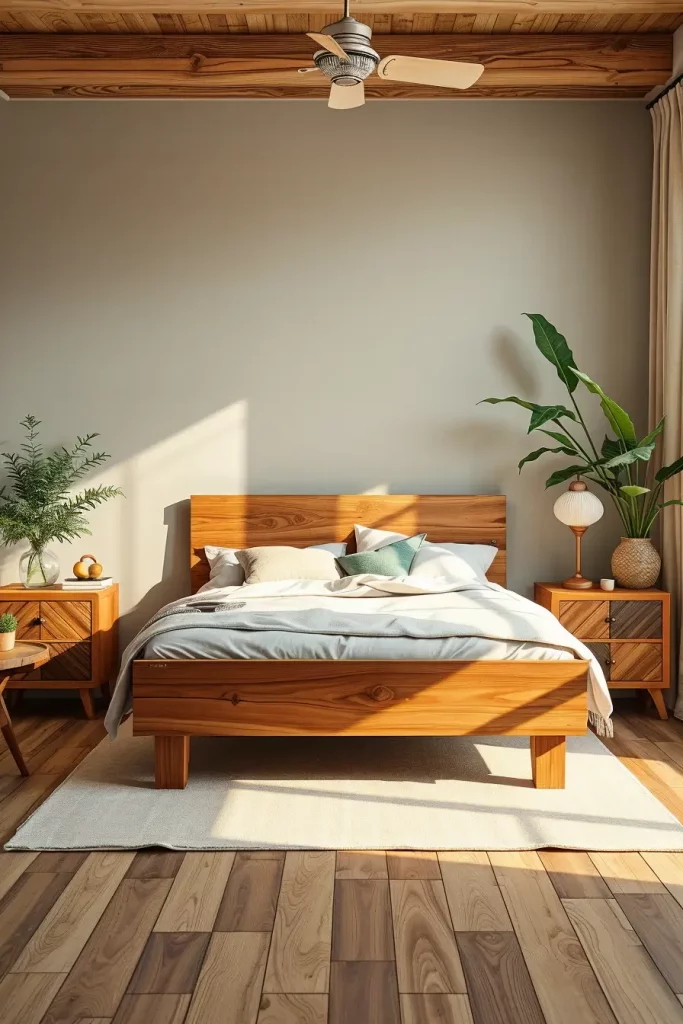
Reclaimed wood not only reduces demand for new timber but embodies the principles of reuse and durability. As Elle Décor highlights, top designers prize reclaimed wood for its effortless sustainability and timeless beauty.
For maintenance, I recommend eco-friendly oils over chemical varnishes to preserve the wood’s natural allure and maintain a healthy indoor environment.
Organic Bedding: The Foundation of Restful, Healthy Sleep
Quality sleep is vital for wellness, and organic bedding is a key component. Materials like organic cotton, linen, and bamboo provide softness and breathability without the harmful pesticides and dyes found in conventional textiles.
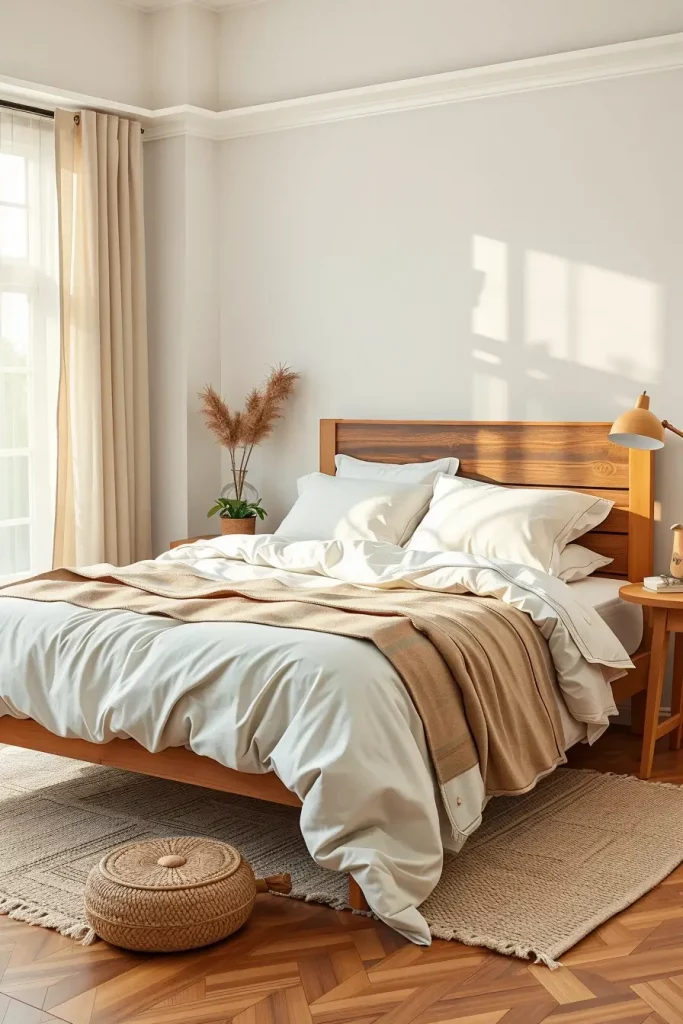
Each bedding element contributes to the eco-chic vibe: organic cotton sheets are soft yet durable, linen duvet covers offer elegance and airflow, and bamboo blankets provide warmth without weight.
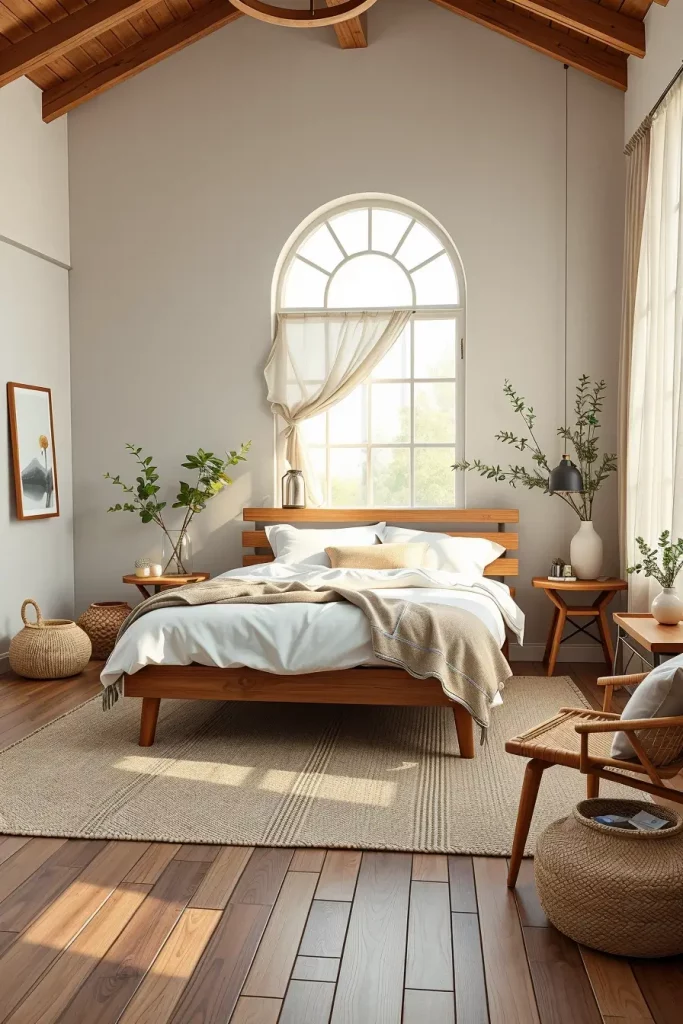
From personal experience, organic bedding maintains freshness longer and reduces allergic reactions. Publications like Better Homes & Gardens emphasize that organic textiles not only protect the environment but also enhance health by limiting toxin exposure.
For added comfort and sustainability, I suggest layering organic cotton sheets with linen pillowcases, combining texture and eco-friendliness seamlessly.
Natural Fiber Rugs: Eco-Friendly Flooring with Texture
Floor coverings are essential for warmth and coziness in an eco-chic bedroom. I prefer natural fiber rugs such as jute, sisal, and seagrass, which are biodegradable and sourced from renewable materials.
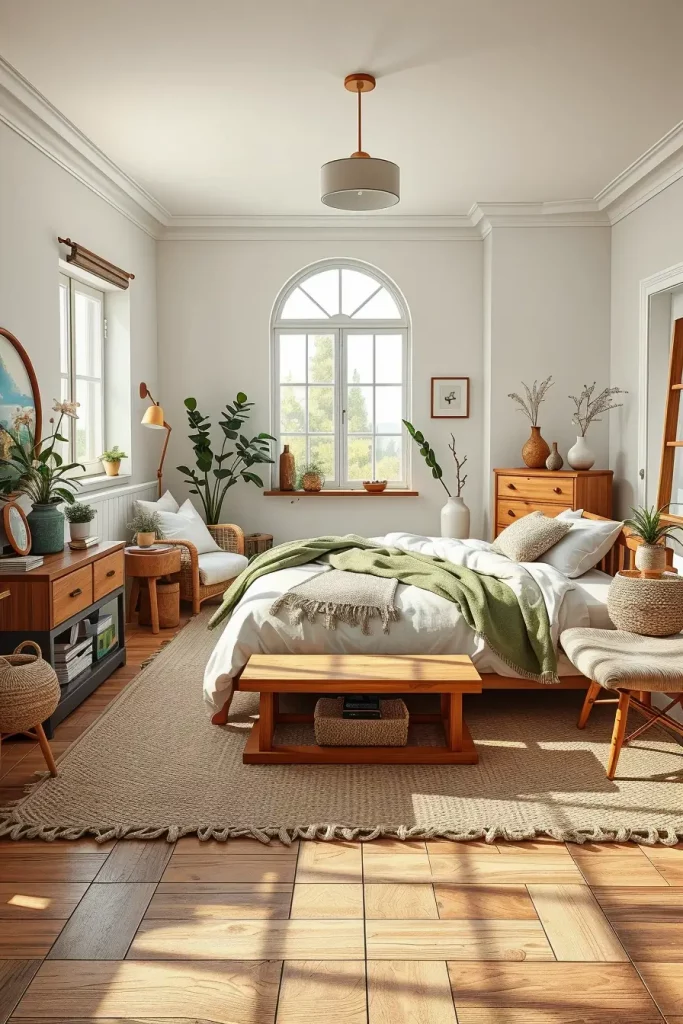
A jute rug introduces a soft, earthy tone, while sisal’s durability makes it ideal for high-traffic areas like beside the bed. Seagrass rugs add subtle elegance with their natural sheen. Paired with minimalist furniture, these rugs highlight the room’s organic beauty.
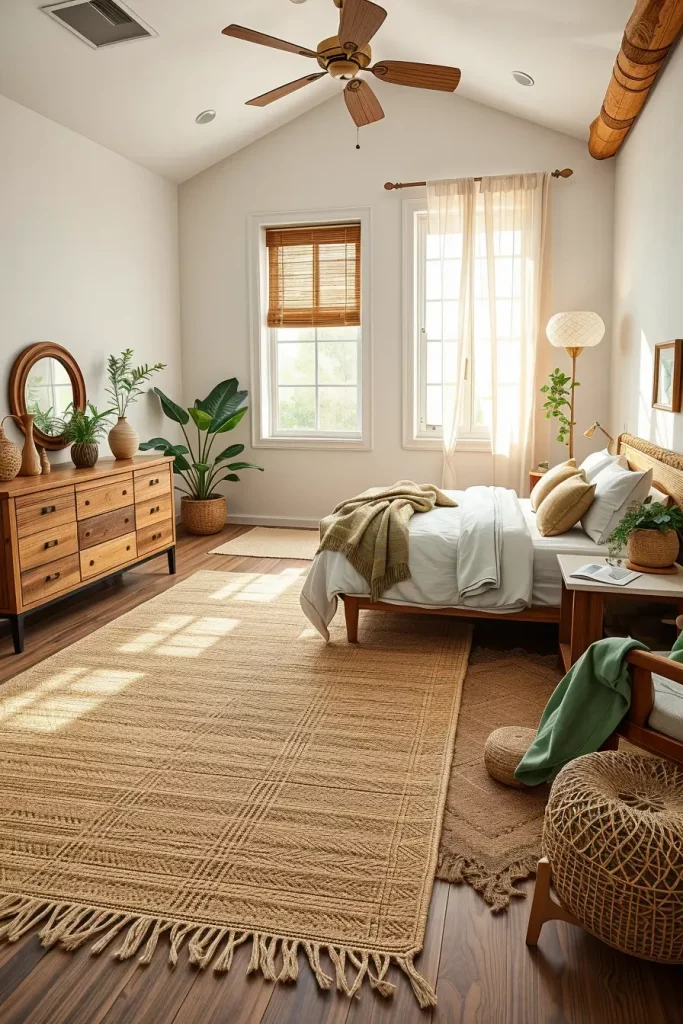
Natural fiber rugs feel more pleasant underfoot compared to synthetic alternatives, which can emit harmful chemicals. Designers featured in House Beautiful often stress how these rugs improve indoor air quality and comfort.
To add visual interest, consider layering a large sisal rug with a smaller, colorful organic cotton rug, injecting personality while maintaining sustainability.
Low-VOC Paints: Creating a Healthier Bedroom Environment
Wall finishes significantly influence a bedroom’s ambiance. I always recommend low-VOC (volatile organic compound) paints to ensure a clean, safe atmosphere. VOCs from conventional paints can release harmful chemicals into indoor air.

With today’s extensive color palettes, I favor muted, earthy hues like soft greens, calming blues, and warm beiges. These shades, combined with natural materials such as wood and linen, create a tranquil backdrop that’s both stylish and healthy.

Within days of applying low-VOC paints, I’ve noticed improved air quality and easier breathing. Architectural Digest highlights how families, especially those with allergy sensitivities, benefit greatly from these choices.
For added texture and natural appeal, consider limewash or clay-based paints, which are low in VOCs and enhance the eco-chic aesthetic.
Eco-Conscious Lighting: Balancing Function and Style
Lighting is a vital element in bedroom design, impacting both functionality and mood. I prioritize sustainable lighting solutions that complement natural daylight and create layered illumination without overwhelming the space.
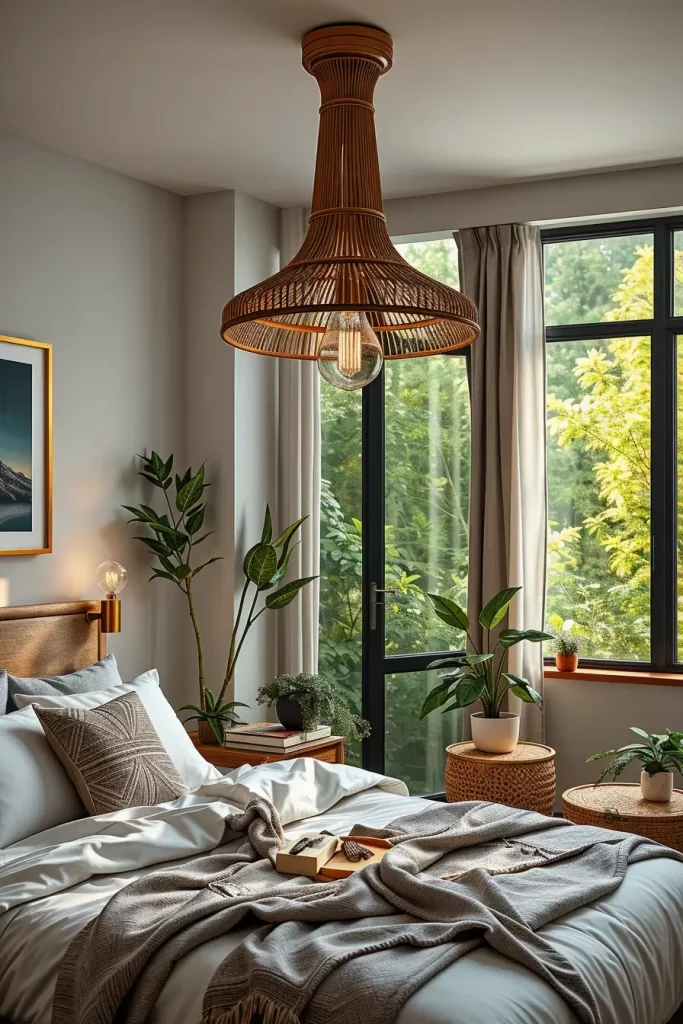
My lighting strategy combines task, accent, and ambient fixtures. Overhead pendant lights crafted from bamboo or recycled metals add eco-friendly charm. Reclaimed wood lamps with LED bulbs create cozy reading nooks. Dimmers provide control over light intensity, allowing you to tailor the atmosphere to your mood.

Thoughtful lighting supports circadian rhythms, enhancing sleep quality. Strategic placement of mirrors and light-colored walls maximizes natural light, reducing the need for artificial illumination and conserving energy.
Energy-Efficient LED Fixtures: Style Meets Sustainability
LED lighting is a cornerstone of eco-chic bedrooms, offering significant energy savings and longevity-lasting up to 25 times longer than traditional bulbs.

Modern LED fixtures have evolved beyond utilitarian designs. Sleek, warm-toned options include wall sconces with minimalist frames, pendant lights with frosted shades, and even headboards integrated with LED lighting.

Publications like Dwell showcase how eco-friendly lighting can be elegant and inviting. Additionally, LED strip lights behind headboards or framing beds add ambient glow efficiently, elevating the room’s design without environmental compromise.
Bamboo: The “Green Steel” of Sustainable Furniture
Bamboo’s rapid growth and durability make it a standout sustainable material-often dubbed the “green steel” of interior design. It’s a superior alternative to hardwood for eco-friendly furniture.

I incorporate bamboo in bed frames, shelving, and lamp bases. Its natural grain complements eco-chic interiors featuring soft greens, whites, and beiges. Bamboo dressers and wardrobes offer a modern yet timeless appeal, adding subtle sophistication.

As noted by Architectural Digest, bamboo’s renewability and resilience make it a smart investment for sustainable luxury, fitting seamlessly into minimalist, modern, or rustic styles. Pairing bamboo with organic fabrics or cork adds texture and breaks monotony.
Cork Accents: Adding Warmth and Uniqueness
Cork is another sustainable favorite, harvested sustainably from cork oak bark. It’s renewable, biodegradable, and adds a distinctive warmth to interiors.
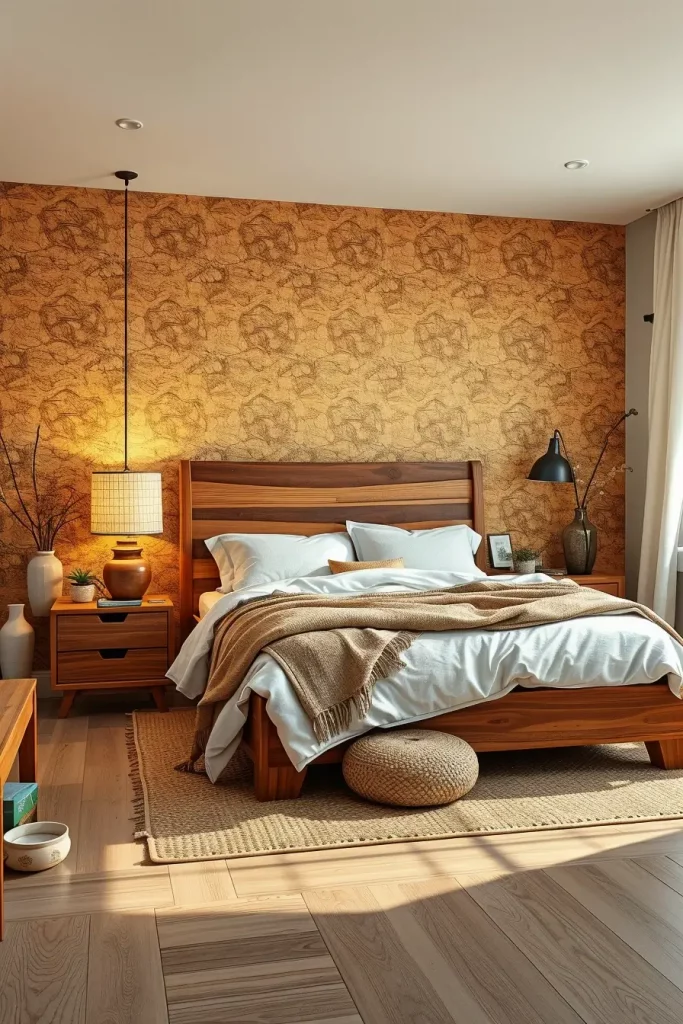
Ideal for accent walls, flooring, and headboards, cork softens sound and creates a cozy atmosphere. Smaller cork accessories like bulletin boards and lamp bases provide charming finishing touches.
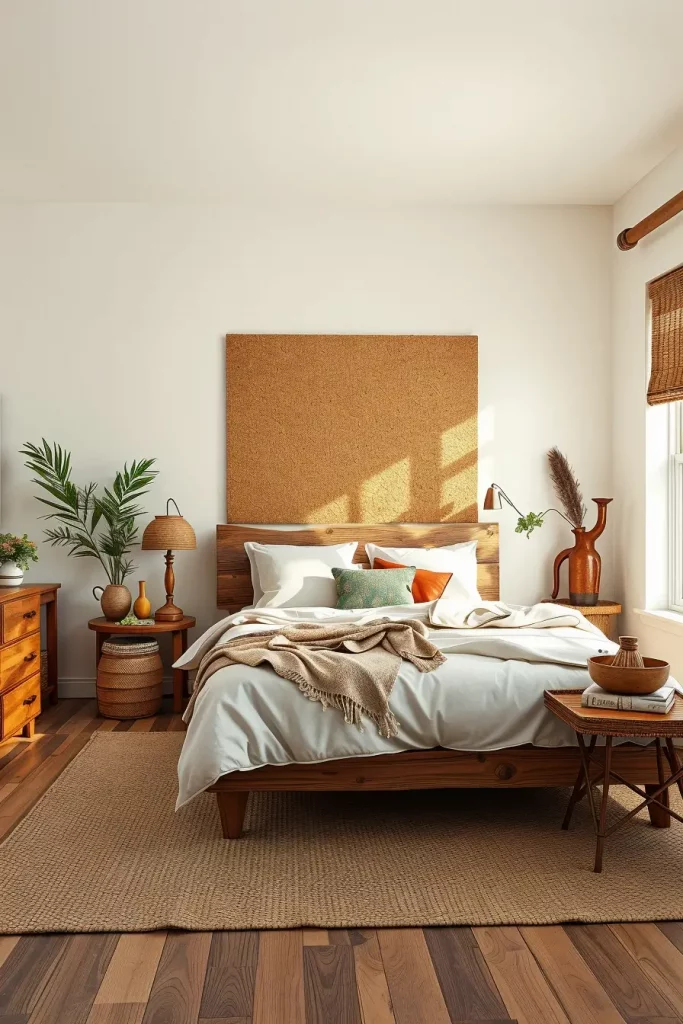
Cork’s tactile quality and temperature regulation contribute to a calming environment, as highlighted by House Beautiful experts. I recommend pairing cork with reclaimed wood furniture and organic textiles to complete the eco-chic look.
Eco-Friendly Mattresses: Prioritizing Sleep and Sustainability
Eco-conscious mattresses are a cornerstone of wellness and sustainability. Made from organic latex, wool, and cotton, they avoid synthetic foams and harmful chemicals that degrade sleep quality and the environment.

I favor brands certified by GOTS or GREENGUARD, which use natural latex and organic wool. Wool naturally wicks moisture and regulates temperature, complementing organic bedding to create a healthy sleep environment.
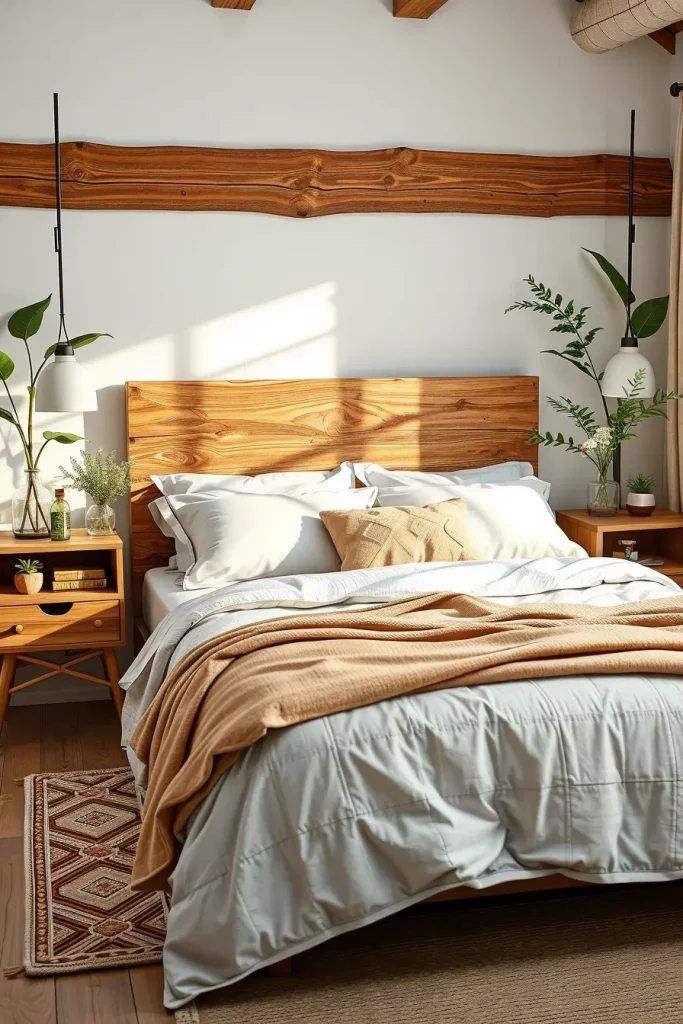
Eco-friendly mattresses maintain their shape and reduce allergens and toxins, improving sleep quality, as supported by Sleep Foundation experts. They also lack chemical odors, enhancing comfort.
Choosing the right firmness is essential for ergonomic support and sustainability, ensuring restful sleep without compromising eco-values.
Smart Storage Solutions for Compact Eco Bedrooms
Designing sustainable furniture for smaller bedrooms presents both challenges and opportunities. Functional, space-saving pieces are key.
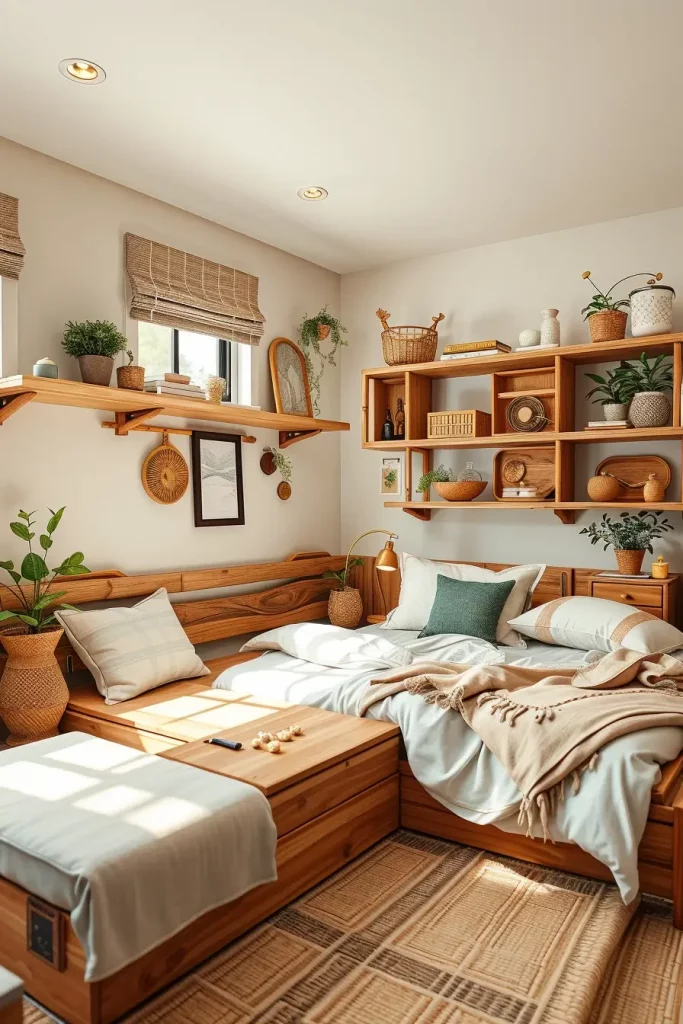
I recommend cork organizers, bamboo shelves, and reclaimed wood storage beds. Recycled metal floating shelves and storage benches blend utility with eco-chic style.

Multifunctional furniture reduces clutter and maximizes efficiency. Apartment Therapy highlights vertical storage as an often overlooked but vital eco-friendly strategy. Modular, adaptable storage solutions accommodate changing needs while minimizing environmental impact.
Upcycling: Personalized Eco-Friendly Decor
One of the joys of eco-chic design is upcycling-transforming old items into unique, sustainable décor.
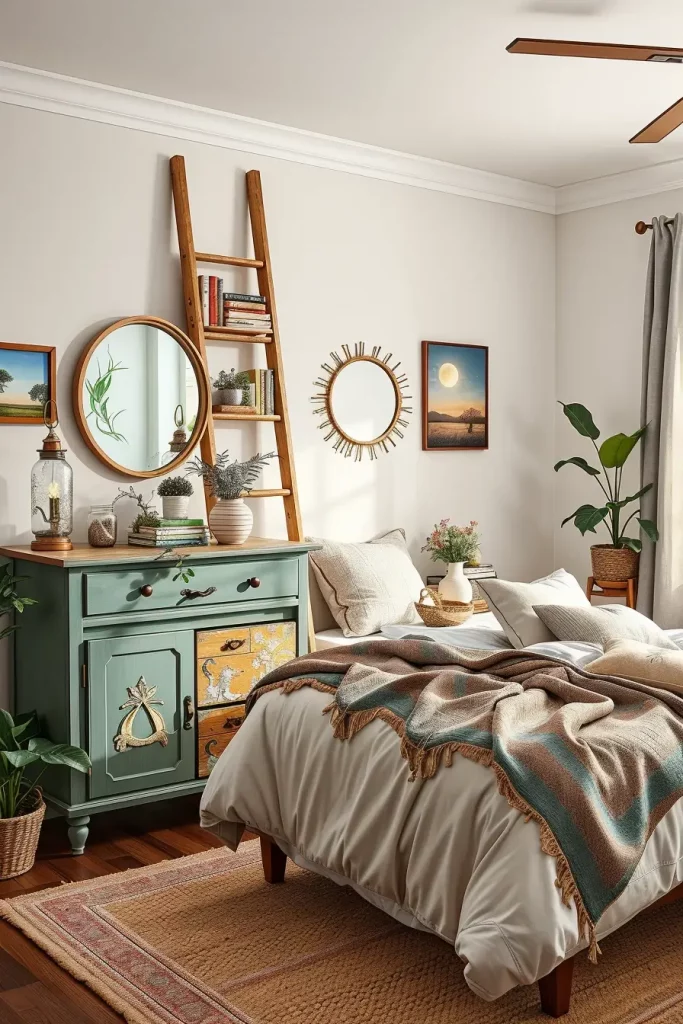
I’ve repurposed vintage dressers with low-VOC paint, converted glass jars into bedside lamps, and turned old ladders into bookshelves. These pieces add warmth and authenticity, each carrying a story.

Upcycled items offer distinctiveness that mass-produced furniture cannot match. Elle Décor advocates blending contemporary and timeless pieces for layered, meaningful interiors.
Even simple upcycling-like sewing pillow covers from fabric scraps or repainting thrifted nightstands-can dramatically refresh a room while being eco-conscious.
Minimalism: A Sustainable Design Philosophy
Minimalism is a powerful tool for eco-friendly bedroom design. Contrary to misconceptions, it’s not cold or empty but intentional and resourceful. By eliminating excess, you reduce waste and focus on purposeful, multifunctional furniture.
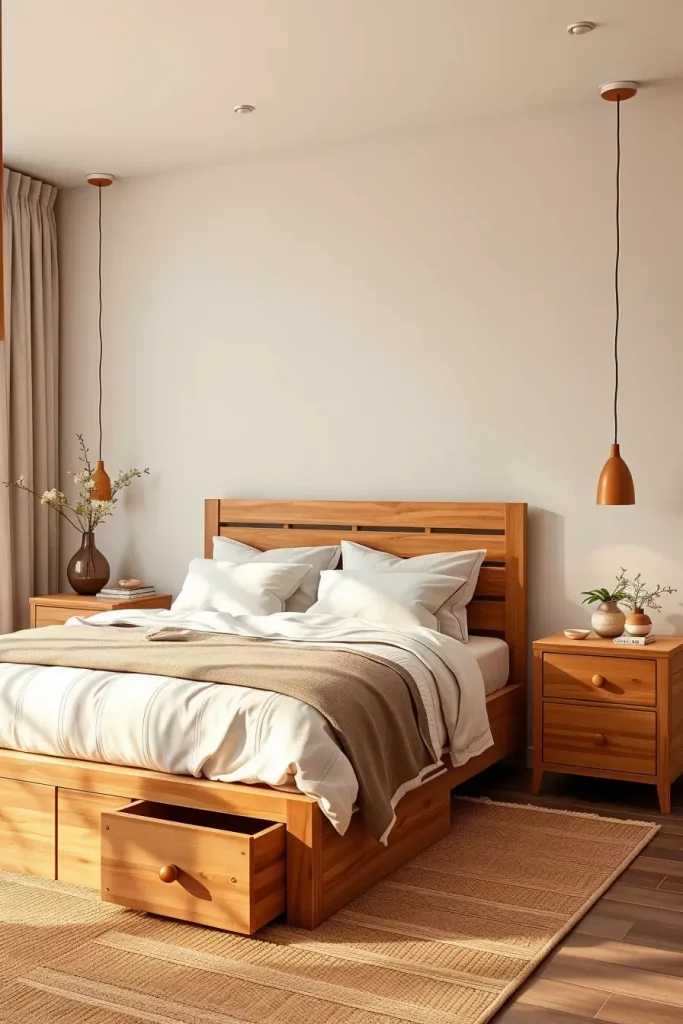
I select pieces like wooden beds with built-in storage and bamboo or organic cotton nightstands. Every item serves a function, keeping the space uncluttered and serene.
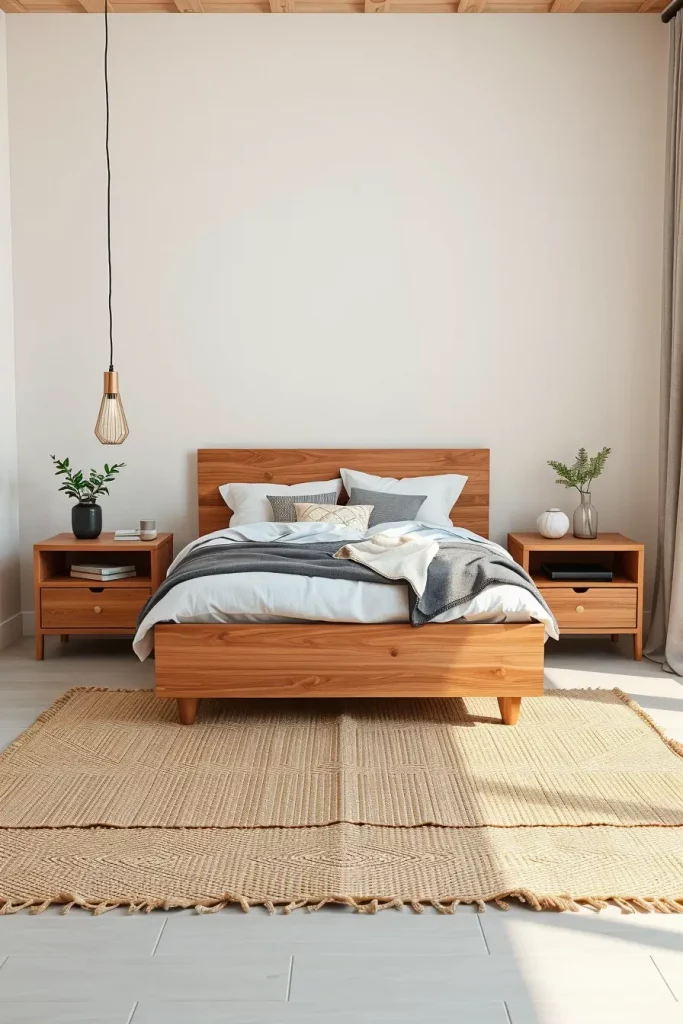
Clients often report that minimalism encourages conscious living. Owning fewer, cherished items creates a timeless, personal space. Designers like Nate Berkus emphasize that minimalism is about abundance in quality, not quantity.
To soften minimalism’s simplicity, I recommend warm, inviting lighting such as pendant lamps with eco-friendly LED bulbs.
Eco-Friendly Window Treatments for Energy Efficiency
Windows significantly influence bedroom design and energy use. Sustainable window treatments made from hemp, linen, or organic cotton filter light naturally while maintaining eco-integrity.
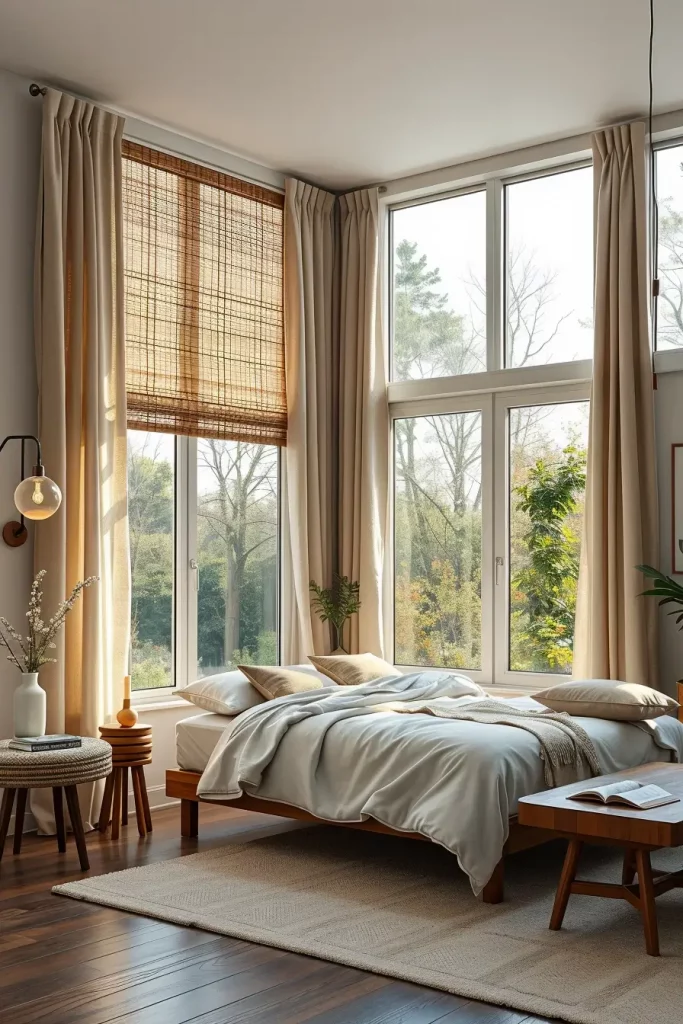
I enjoy layering natural linen drapes with bamboo blinds for a practical yet elegant look. Temperature-regulating blackout curtains made from recycled fibers improve energy efficiency by reducing heating and cooling demands.
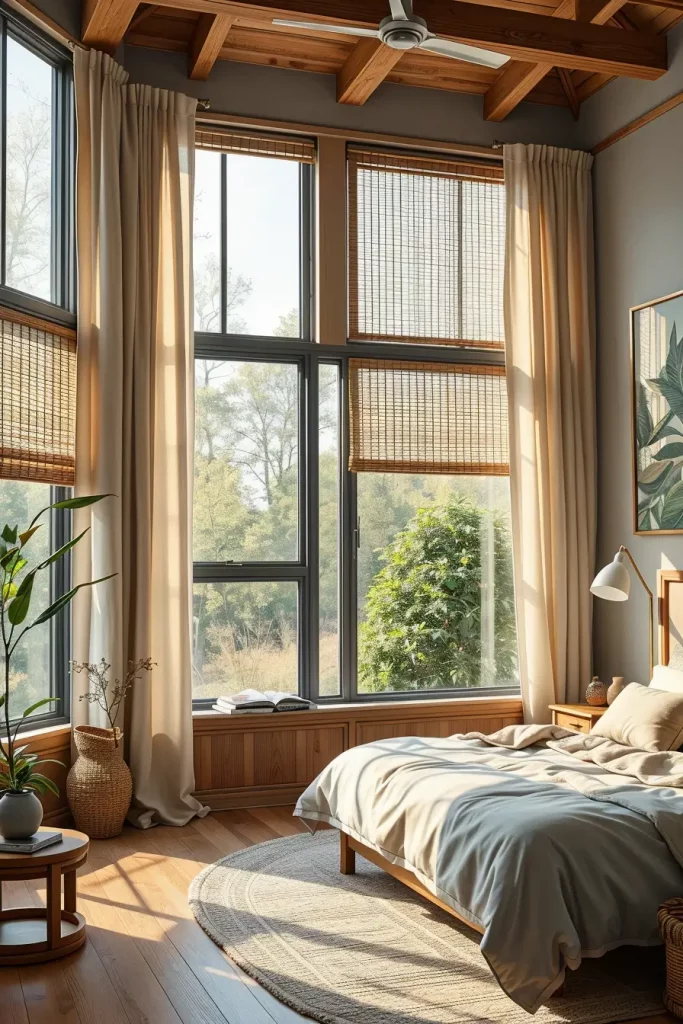
Clients appreciate how these shades enhance privacy and lower energy costs. Architectural Digest highlights eco-friendly window treatments as a growing trend in sustainable interiors.
For added eco-benefit, consider energy-efficient curtain rods made from recycled aluminum to further reduce heat loss.
Bringing Nature Indoors with Houseplants
Integrating greenery is essential in sustainable bedroom design. Indoor plants purify air, increase humidity, and foster a calming connection to nature.
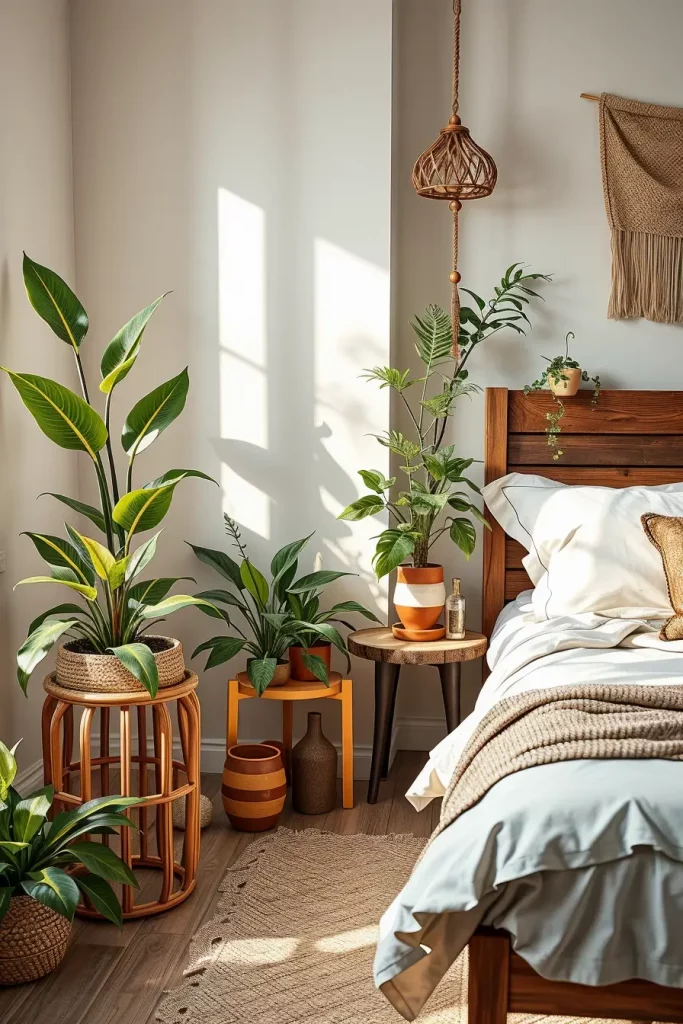
My favorites include snake plants, peace lilies, and ferns-low-maintenance options that effectively cleanse the air. I place them in rattan planters, reclaimed wood stands, or natural clay pots to complement the eco-chic style.

Clients often report improved relaxation and sleep quality after adding plants. Biophilic design principles, which integrate nature indoors, are increasingly recognized for enhancing human health.
For smaller spaces, hanging planters or vertical garden shelves maximize greenery without sacrificing floor area.
Natural Color Schemes for a Serene Ambiance
Choosing a natural color palette sets the tone for an eco-chic bedroom. I gravitate towards muted earth tones-beiges, soft greens, gentle blues, and warm browns-that evoke tranquility and connection to nature.

Walls painted in calming sage or clay beige with low-VOC paints provide a restful backdrop. Organic cotton bedding in soft cream complements the palette, while natural wood furniture grounds the space.

Natural palettes encourage focus on simplicity and relaxation. Elle Décor endorses earth tones for their timelessness and sustainability.
To add depth, incorporate accent pillows or throws in richer hues like terracotta or olive.
Incorporating Stone and Clay for Organic Texture
Stone and clay elements bring authenticity and tactile richness to eco-chic bedrooms. Their durability and biodegradability make them sustainable choices.

I use clay pots for plants, stone side tables, and clay pendant lights to warm the room’s atmosphere. These natural accents balance wood furniture and organic fabrics beautifully.

Clients appreciate the organic aesthetic and longevity of stone and clay. For a striking focal point, textured clay wall tiles behind the bed create a serene centerpiece while maintaining eco-friendliness.
Recycled Metal: Modern Eco-Friendly Accents
Though metal is often overlooked in sustainable design, recycled metals like steel, aluminum, and brass play a vital role in eco-chic bedrooms.
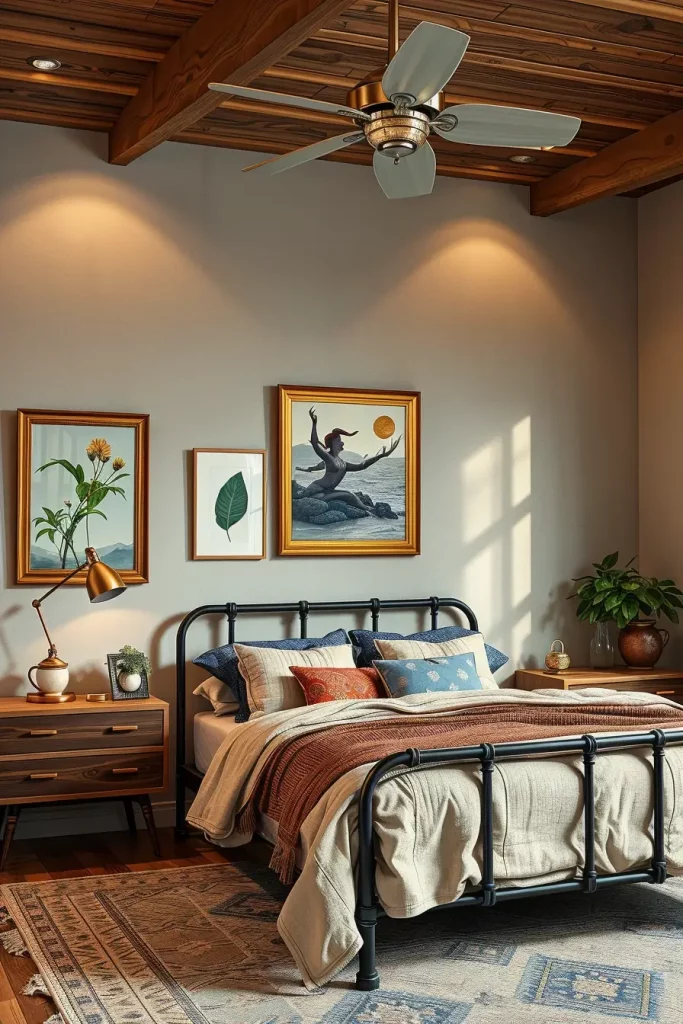
I incorporate recycled metal in light fixtures, decorative accents, frames, and furniture details. When used sparingly alongside warm materials like reclaimed wood, metal adds a contemporary edge without sacrificing coziness.

Clients value recycled metals for their durability and low maintenance. House Beautiful notes the rising trend of metal alternatives to plastic and wood in sustainable design.
Adding a ceiling fan made from recycled aluminum can enhance energy efficiency while complementing the eco-chic aesthetic.
Non-Toxic Adhesives and Finishes: Protecting Health and Environment
Often overlooked, the choice of adhesives and finishes is crucial in sustainable interiors. Many conventional products emit VOCs harmful to health and the environment.
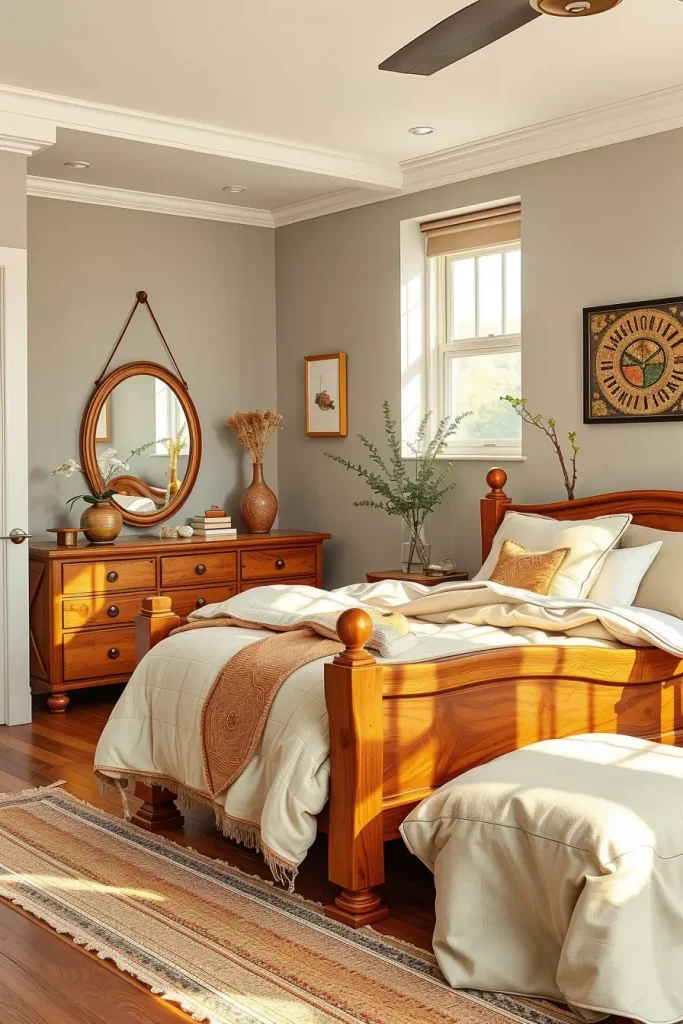
I prefer water-based adhesives and plant-derived varnishes or oils like linseed. These protect surfaces while ensuring indoor air quality remains high. For example, a bed frame finished with non-toxic oils preserves natural beauty without introducing toxins.

Switching to non-toxic finishes significantly reduces indoor VOCs, aligning with EPA recommendations for healthier homes.
For DIY enthusiasts, natural beeswax polish is an excellent eco-friendly option that adds shine to wood and glass surfaces.
Water-Based Stains: Enhancing Wood Sustainably
Water-based stains are my go-to for furniture and flooring in eco-chic bedrooms. Unlike oil-based stains, they emit fewer VOCs, promoting healthier air quality.

I favor reclaimed hardwood floors stained in natural oak or walnut tones. Water-based stains on bedside tables, wardrobes, and accent walls reveal wood grain beautifully while maintaining an organic look.

Clients immediately notice the improved ventilation and calming effect. Dwell and other design outlets endorse water-based stains as essential for sustainable interiors.
Complement the space with sustainable jute or hemp rugs to complete the natural flooring aesthetic.
Multi-Functional Furniture: Maximizing Sustainability and Space
Furniture that serves multiple purposes is a hallmark of eco-friendly design. It reduces production needs and optimizes space.
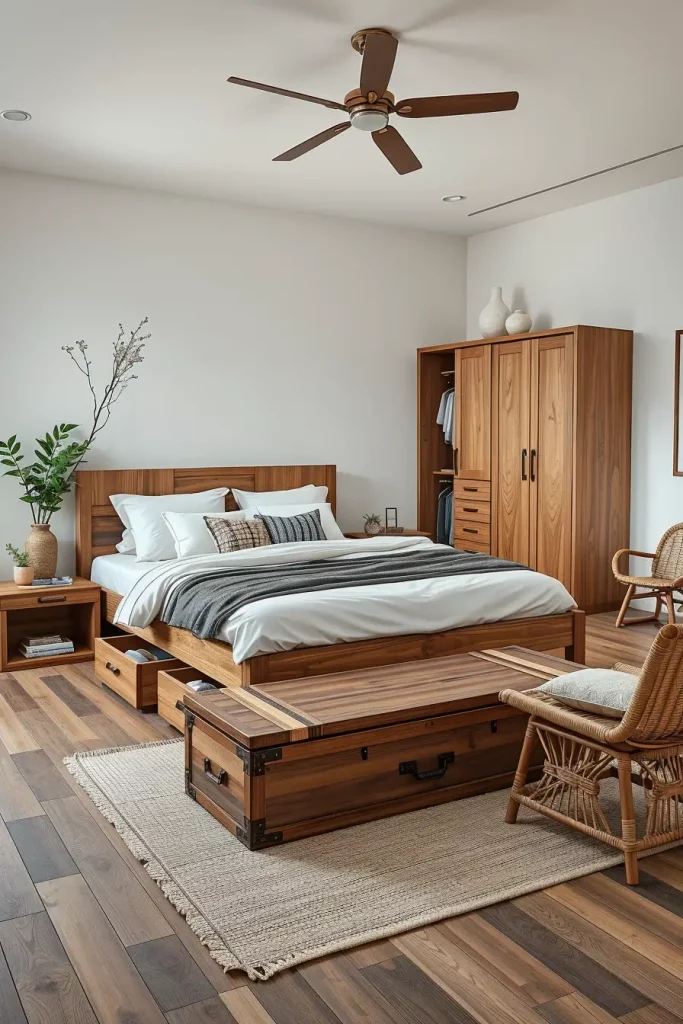
Favorites include storage beds, modular wardrobes, fold-down desks, hollow bamboo benches, and reclaimed wood trunks at the foot of the bed. These pieces combine style and function, helping maintain a clutter-free environment.

Clients appreciate how multifunctional furniture enhances lifestyle and space efficiency. Designers like Kelly Wearstler emphasize that smart furniture choices merge luxury with sustainability.
Consider adding a rattan lounge chair with organic fabric for a cozy reading nook that doubles as seating.
Embracing Slow Design and Thoughtful Consumption
Eco-chic bedrooms embody a mindset beyond products-slow design encourages mindful purchasing of durable, meaningful items.
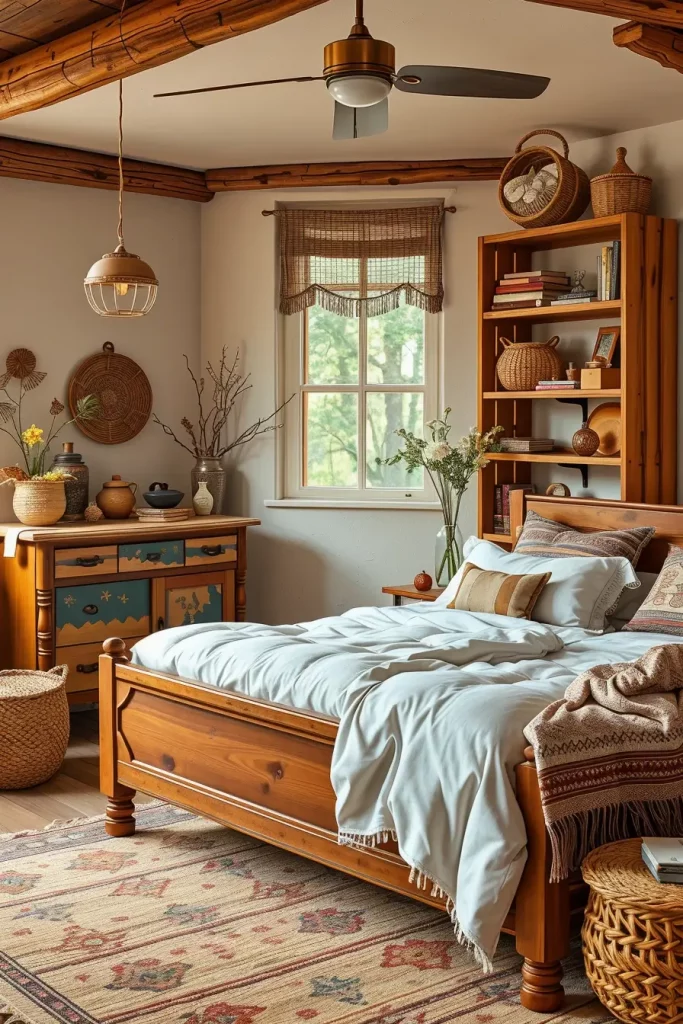
Slow design favors handcrafted furniture, ethically made textiles, and vintage pieces that resist trends. This approach combats overproduction and supports ethical supply chains.
Clients find the process of carefully selecting pieces rewarding, creating intimate, anchored spaces. The New York Times has extensively covered slow design as a lifestyle movement.
Adding curated bookshelves or handwoven baskets can express slow design’s values of patience and artistry.
Handcrafted Accessories: Ethical and Authentic Touches
Accessories complete the eco-chic bedroom, and I prefer handmade items that support artisans and sustainability.

Woven wall hangings, hand-thrown ceramics, and organic wool rugs add warmth and authenticity. Each piece tells a story, enriching the bedroom’s character.
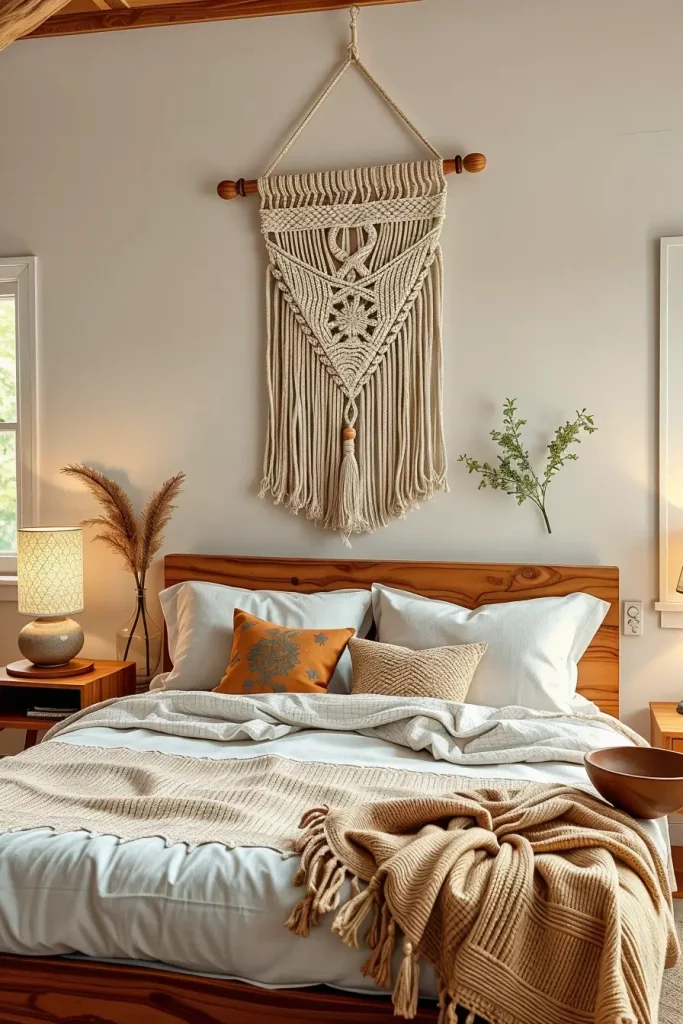
Clients cherish these unique items more than mass-produced décor. Dezeen highlights the growing importance of ethical accessories in sustainable design.
For finishing touches, artisanal candle holders and handmade clay bowls on nightstands make subtle yet powerful ethical statements.
Luxury Meets Sustainability in Eco-Friendly Bedrooms
Many believe luxury and eco-friendliness are incompatible, but an eco-chic bedroom can be both elegant and sustainable.
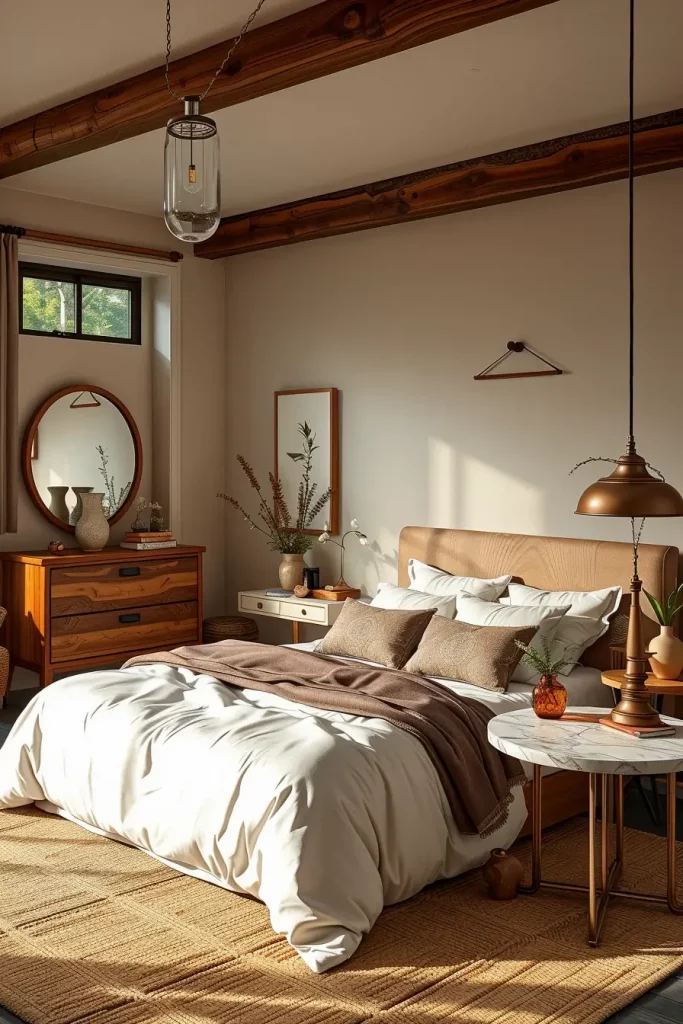
Combining organic cotton bedding, ethically sourced wood furnishings, and glass lighting creates a refined yet responsible space. Plush hemp rugs or responsibly sourced wool throws add luxurious comfort underfoot.

Clients often feel enlightened realizing sustainability can embody true luxury, which Elle Décor defines as quality over excess.
Accent furniture in marbled eco-friendly leather or reclaimed wood instantly elevates the room’s sophistication.
Balancing Natural and Artificial Light
Lighting balance is crucial in eco-friendly bedrooms. Maximizing natural light through large windows and sheer linen curtains creates soft, energy-efficient illumination.

Mirrors strategically placed reflect daylight, reducing the need for artificial lighting. Solar tubes or skylights further enhance natural illumination sustainably.

Bedrooms with ample natural light feel healthier and more uplifting, a fact emphasized by Architectural Digest.
Complement natural light with dimmable LED fixtures to maintain a warm, energy-efficient ambiance after sunset.
Eco-Friendly Art and Wall Decor
Art adds personality to eco-chic bedrooms while supporting sustainability. I focus on pieces made from recycled materials, natural pigments, or created by eco-conscious artists.

Options include framed prints on recycled paper, natural fiber wall hangings, and reclaimed wood sculptures. DIY projects using upcycled fabric or clay tiles also make creative, eco-friendly décor.
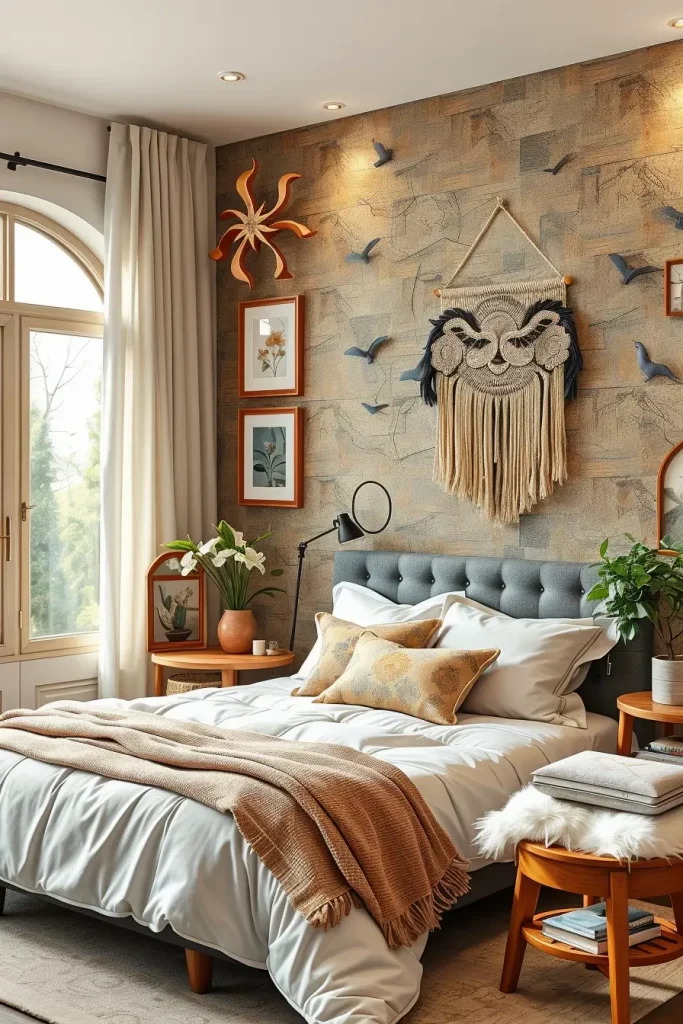
Such artworks define style while honoring eco-values. Wallpaper* magazine notes the rising popularity of sustainable art in interiors.
For a bold statement, consider a textured feature wall using eco-friendly fibers or sustainable wallpaper to anchor the room’s design.
Eco-Friendly Decluttering and Organization
Reducing clutter is foundational to sustainable bedroom design. Minimalist, organized spaces feel peaceful and functional, enhancing mental well-being.

I favor multifunctional furniture like beds with built-in drawers and wardrobes made from reclaimed wood. Woven baskets from natural fibers provide stylish, practical storage. Open shelving displays everyday essentials while reducing waste.

The mantra “less is more” guides sustainable living. Architectural Digest emphasizes decluttering as the first step toward eco-consciousness, reducing consumption and waste.
Stackable bamboo boxes or collapsible organizers made from organic cotton add flexible, eco-friendly storage options.
Long-Term Advantages of a Green Bedroom
Designing with sustainability in mind yields lasting benefits: improved air quality, reduced energy consumption, and cost savings. Natural materials and soothing colors invite restful sleep and tranquility.
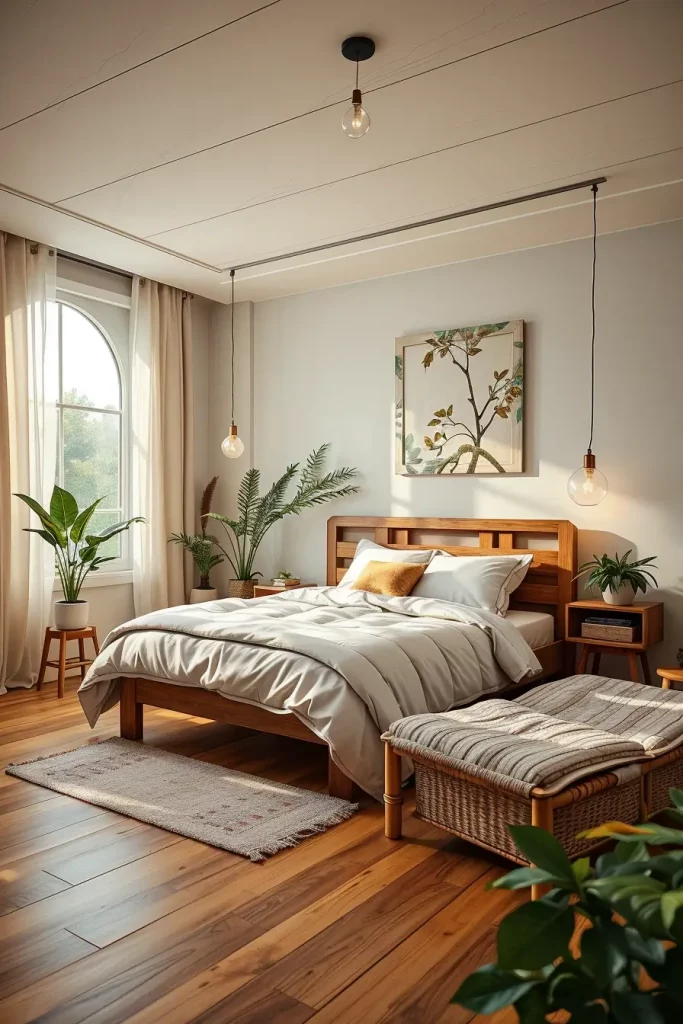
Key elements include organic cotton or bamboo bedding, natural wood floors, and non-toxic paints. Energy-efficient lighting like LED or smart dimmable bulbs further reduce environmental impact.
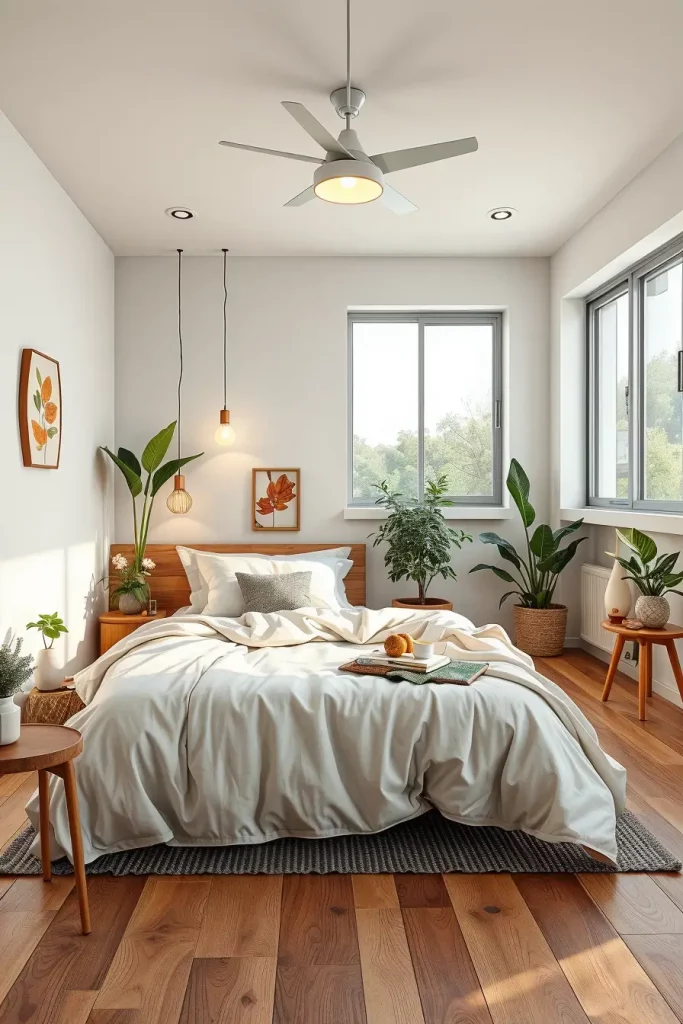
These green practices enhance lifestyle and space quality. The New York Times highlights how sustainable interiors reduce allergens and improve sleep through better ventilation and healthier materials.
Adding an energy-efficient air purifier with recyclable components can further elevate indoor air quality.
Budget-Friendly Eco-Chic Design Strategies
“Sustainability is too costly” is a common misconception. In my experience, eco-chic bedrooms can be affordable by incorporating secondhand furniture, repurposed items, and DIY projects.
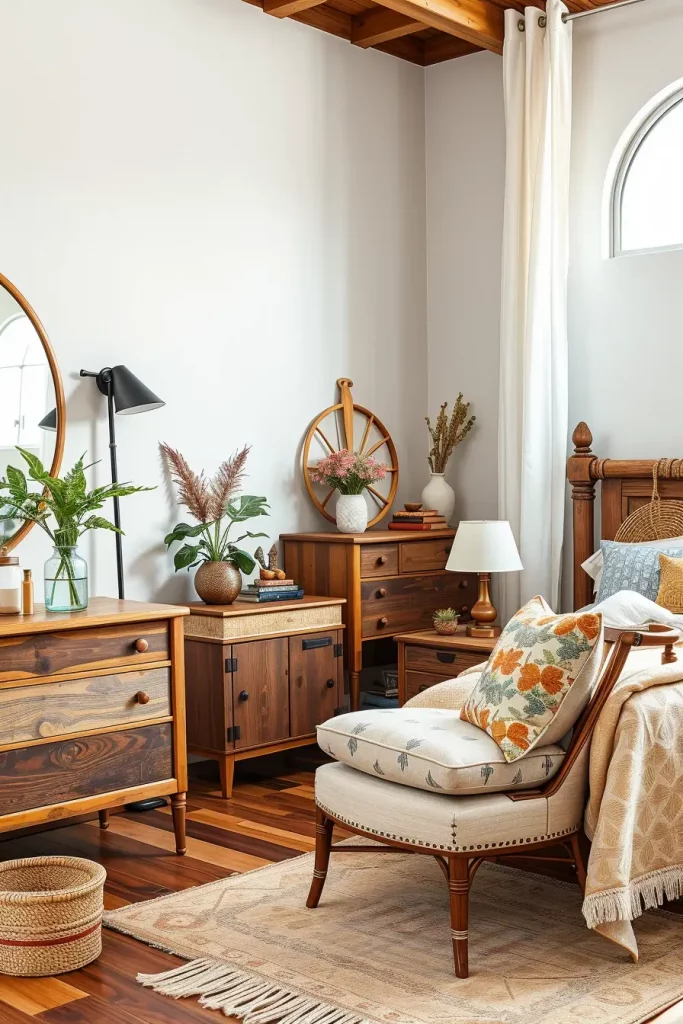
Thrift shops and online marketplaces offer solid wooden dressers and chairs perfect for refinishing with eco-friendly materials. Swapping traditional hardware for bamboo or recycled metal handles upgrades style sustainably.
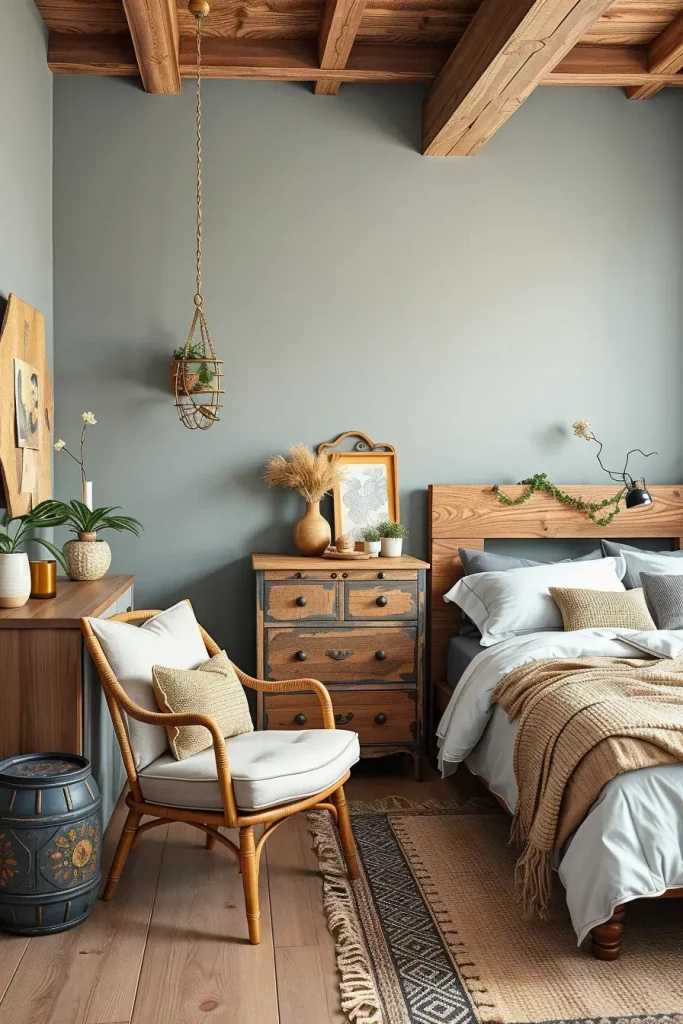
DIY projects like crafting headboards or nightstands from reclaimed wood add unique charm at low cost. Apartment Therapy endorses repurposing furniture as a top way to reduce expenses and carbon footprint.
Energy-saving features such as organic thermal curtains help maintain eco-friendly aesthetics while cutting heating and cooling costs.
Final Reflections on Sustainable Bedroom Design
Balance is essential in eco-friendly bedroom interiors. Sustainable design blends style with environmental responsibility, reflecting a lifestyle that nurtures both health and the planet.
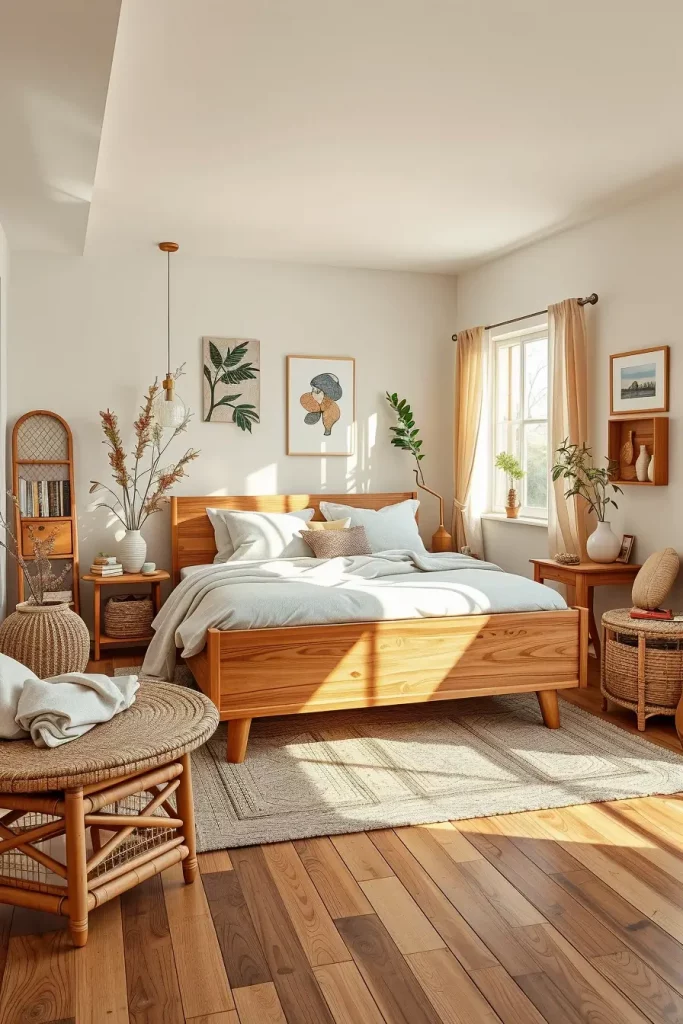
Natural materials like wood, linen, and bamboo bring warmth and harmony. Minimal clutter and smart furniture choices create functional, peaceful spaces. Even small eco-friendly touches like recycled décor and organic bedding leave a lasting impact.

This design philosophy is poised to shape the future. As Kelly Wearstler notes, beauty is integral to sustainability. Thoughtful integration of energy-efficient technology can support environmental goals without compromising the room’s natural ambiance.
An eco-chic bedroom embodies mindful living-a holistic approach that combines eco-friendly materials, energy-saving lighting, and upcycled décor to create a modern, cozy retreat that honors the planet and your well-being.
What are your thoughts on designing an eco-chic bedroom? Share your ideas in the comments below; your perspective is invaluable.

